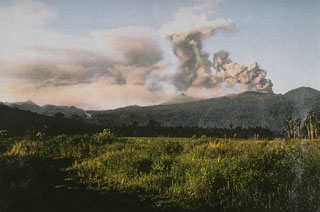Report on Dukono (Indonesia) — August 1978
Scientific Event Alert Network Bulletin, vol. 3, no. 8 (August 1978)
Managing Editor: David Squires.
Dukono (Indonesia) Strongest explosions in many years
Please cite this report as:
Global Volcanism Program, 1978. Report on Dukono (Indonesia) (Squires, D., ed.). Scientific Event Alert Network Bulletin, 3:8. Smithsonian Institution. https://doi.org/10.5479/si.GVP.SEAN197808-268010
Dukono
Indonesia
1.6992°N, 127.8783°E; summit elev. 1273 m
All times are local (unless otherwise noted)
Geologists Muslim Monoarta and Peter Jezek visited Dukono from 20-25 July. Activity had begun to intensify 4-7 days before their arrival and explosions of varying strength occurred about once every 10 seconds during their visit, ejecting bombs as large as 4 m in longest dimension. The bombs fell 200-250 m from the crater rim. Several 6-8-hour periods of quiescence interrupted the explosions, always at night. Ash emission was nearly continuous, with clouds rising as high as 10 km above the crater. The ash ranged from black sand-size particles to very fine light gray clay-size material.
On 21 July, fine light gray ash was blown N beyond the town of Galela, 15 km from the volcano. Moderate ashfall continued through most of the day on the 21st and during the morning of the 22nd. During the night of 23-24 July, the loudest explosions in many years rattled windows in Galela and incandescent ejecta were visible.
Geological Summary. The Dukono complex in northern Halmahera is on an edifice with a broad, low profile containing multiple peaks and overlapping craters. Almost continuous explosive eruptions, sometimes accompanied by lava flows, have occurred since 1933. During a major eruption in 1550 CE, a lava flow filled in the strait between Halmahera and the Gunung Mamuya cone, 10 km NE. Malupang Wariang, 1 km SW of the summit crater complex, contains a 700 x 570 m crater that has also had reported eruptions.
Information Contacts: M. Monoarta, Volcanology Division, GSI; P. Jezek, SI.

